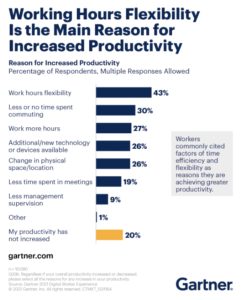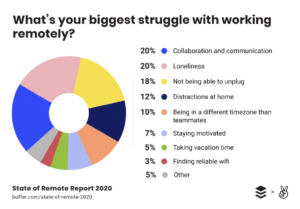
One thing is clear about the world of work: hybrid working, where people split their time between working in the office and working remotely, is going to be the norm for many employers in the near future — and possibly for much longer.
Our research on employee attitudes shows that 64% of employees in the US and UK want to permanently be able to choose when to work in the office, home and in an approved public space. And why wouldn’t they? Hybrid working and other types of flexible work arrangements are tied to higher levels of productivity and engagement.
According to a 2021 Gartner survey, 43% of workers attributed their increased productivity to flexible working hours, and 30% said it was because of less or no time commuting.
Source: Gartner
Download: The Hybrid Workplace: An Employee Census Report
However, as many employers, managers and even employees themselves have learned over the past two years, hybrid and remote working come with their share of challenges. According to a Harvard Business Review report, most of these challenges hinge on one major factor: communication.
This issue is echoed in Buffer’s State of Remote Work 2020 report, in which 20% of remote workers said that their biggest struggle with working remotely during the pandemic was collaboration and communication.
Source: Buffer State of Remote Work 2020
The reliance on technology and asynchronous communication, as well as the lack or absence of physical interaction, introduces practical difficulties to remote and hybrid working environments. These challenges are unlikely to go away on their own; on the contrary, failing to proactively recognise and manage them could lead to things getting worse over time.
So what exactly can organisational leaders do?
The answer might lie in going back to basics — to an established and often-quoted framework known as the 7 Cs of communication.
What are the 7 Cs of communication?
First outlined in Scott M. Cutlip and Allen H. Center’s revolutionary 1952 book Effective Public Relations, the “7Cs of Communication” is a popular framework that posits seven principles of successful communication, each one starting with the letter C. The 7 Cs framework has been quoted in multiple books about business, marketing, publications and communications and has undergone numerous modifications over the years. However, the original list was as follows:
- Clarity (also known as Clearness)
- Conciseness
- Completeness
- Consideration
- Concreteness
- Correctness
- Courtesy.
Each principle addresses a critical element of communication, with Cutlip and Center providing best practices on how to leverage them when engaging other people. But how can employers use them in remote/hybrid workplaces?
How to apply the 7 Cs of communication in your hybrid working environment
The great thing about the 7 Cs of communication is that, as basic concepts of successful communication, they can be implemented in a wide range of contexts, environments and applications. Here’s a closer look at how to apply them to support hybrid team effectiveness.
Related Reading: Remote Work — Our Top 5 Tips to Manage a Remote Workforce Successfully
1. Clarity
Clarity refers to the ability to communicate your message in a way that is clear and easy to understand. For example, when interacting with team members, you could avoid using jargon or technical language unless necessary — this prevents new employees from feeling lost or alienated.
Cloudbooking Tip: In hybrid and remote work settings, clarity can also mean clearly communicating intent. In co-located workplaces, workers can get clarity on tasks and issues through quick hallway chats with leaders or their peers. This becomes much more difficult in remote settings.
Leaders must be conscious of providing clear directions and fighting uncertainty without resorting to micromanaging. The last thing you want is to inadvertently create a culture where people default to inaction when instructions are vague.
It’s here where open-door policies can do your teams a lot of good. Even if you’re not in a physical office per se, you can create the positive impact of an open-door policy by reminding people that they can always engage with managers and senior-level staff across the organisation. The idea is for managers and executives to leave their office doors “open,” creating a more open and transparent working environment.
Related Reading: What Is an Open Door Policy?
2. Conciseness
If you’ve ever read an “urgent” company memo and lost interest halfway through it, you’re not alone. Far too many company leaders make the mistake of droning on and on in their corporate communications, largely due to a desire to strike an emotional chord with their audience or communicate as many ideas as possible.
The solution to this problem is to make your communications more concise. This simply means removing any fluff or filler from your messages.
Cloudbooking Tip: Let’s face it — virtual meetings are the bane of many remote workers’ lives. But if you ask your team members, there’s a good chance the issue isn’t so much about meetings but more about what happens in them.
Case in point: a 2020 Zippia survey found that over 55% of workers are frustrated by meetings that could have been an email.
Source: Zippia
You can prevent this problem by keeping your meeting agendas clear and concise. Outline the reason for having a Zoom or MS Teams meeting; better yet, set expectations by providing a concrete meeting agenda in advance.
Related Reading: The Cloudbooking Guide to Planning Productive Hybrid Meetings
3. Completeness
Completeness means providing all the necessary information for people to understand your message. Leaving out key details can lead to confusion.
Cloudbooking Tip: If you go with the “let’s not have a meeting if it can be an email” route, make sure your messages are complete and cover all the relevant points you want to communicate.
This is particularly important for asynchronous communication, like emails and updates in group chats or direct messages. Employees should be able to see what’s expected of them and fully understand the message. You want your message to be a single source of truth, at least for a particular task or piece of information.
4. Consideration
Consideration refers to showing respect and thoughtfulness towards people. For example, you can consider your employees’ needs and level of understanding when crafting messages and creating workplace communication policies.
Cloudbooking Tip: A simple way to make your hybrid team’s communications practices simpler and more effective is to create clear and rock-solid rules for things like:
- How to communicate with peers and managers
- How often to communicate with managers
- The mode of communication for types of messages.
These rules will help set expectations and ensure everyone knows practices such as:
- For urgent matters, use instant messaging
- For daily check-ins, use email
- For team huddles, schedule time in meeting rooms during in-office days.
Of course, consideration being the main focus here, it’s a good rule of thumb to consult your teams when creating workplace policies — particularly those concerning how they share information and interact with others.
5. Concreteness
Concreteness means using specific and vivid language in your communication. It means ensuring that any ideas or information you want to share with people uses clear and precise terms to avoid any ambiguity or misunderstanding. Using concrete language makes it easier for people to understand your messages and get to the gist of what you want them to know.
At the more fundamental level, concreteness in communication also means using facts and verifiable observations. If you’re going to tell someone why they need to hit a particular goal, explain why that goal is important and how they can get there.
Cloudbooking Tip: Show, don’t tell. In co-located workspaces, sharing information about a problem or development with a peer or manager is easy — simply show them your laptop or computer screen.
Source: Canva
You can do the same in virtual environments by using screenshots, videos and screen sharing to your advantage. For example, when explaining metrics or key performance indicators, visualise your data using charts and graphs. This has much more impact than simply writing “sales in Q2 of 2022 grew by 32% quarter over quarter and 57% year over year.”
Studies have also shown that using visual media can enhance people’s ability to retain information over time — something to remember when planning training and learning activities for your hybrid workforce.
6. Correctness
Correctness in communication can refer to a range of things, such as:
- Being factually accurate in your communications
- Using technical terms and jargon that align with your audience’s level of knowledge
- Ensuring all names and titles that you mention are spelt correctly
- Checking your writing for grammatical errors and typos.
This may seem like a basic step that any responsible leader would know, but you’d be surprised how often simple mistakes can derail projects and cause damage to an organisation’s image.
Pro Tip: One of the first places you can demonstrate your commitment to communicating correct and accurate information is with a hybrid working policy — a document outlining your organisation’s approach to hybrid working and business parameters. In a nutshell, a hybrid working policy has all the rules for where, when and how employees can work in a new hybrid working environment. It’s a prime opportunity to lay the groundwork for your new working practices and communicate your employees’ legal rights.
Related Reading: How to Write a Hybrid Working Policy — 9 Things to Include
7. Courtesy
Courtesy involves displaying politeness and manners in your communication. However, there are no shortcuts in this area. Habits such as saying “please” and “thank you” in your messages aren’t things you enforce with rules or guidelines. These cultural practices begin from the top of your organisation — so be sure to set a good example.
Cloudbooking Tip: The absence of physical or face-to-face interactions in virtual workplaces can make it easy to misinterpret messages as being rude, cold or confrontational. When your primary method of communication is through Slack or email, employees can and will miss additional context that, in physical offices, would normally be communicated through tone of voice or body language.
Again, the solution here is to set expectations. For example, software company Help Scout reminds employees during their remote onboarding process to always “assume miscommunication over malice.” The company reminds new hires that if they ever feel a co-worker is rude or cross with them, particularly after reading an asynchronous text-based message, it’s best to assume a communication misfire rather than a personal attack.
Bringing it all together
As the modern workplace undergoes rapid transformation, employers must take care to create a cohesive and engaged community of workers, regardless of their physical location.
Technologies such as desk booking software, project management tools, and instant messaging platforms play a critical role in creating a smooth transition to hybrid or fully remote working environments. But the 7 Cs of communication address the underlying factors that could cause communication and collaboration problems as your people transition away from permanent co-located workspaces. Follow these tips to promote communication practices that are clear, concise, and easy to understand.
Find more insights on effective workplace practices by going through the Cloudbooking blog. If you need a cloud-based solution to enable flexible or hybrid work environments, get in touch with the Cloudbooking team. Cloudbooking’s desk and meeting room booking solutions are packed with features to help managers and employees shift to new ways of work. Contact our team today to schedule an obligation-free demo.






